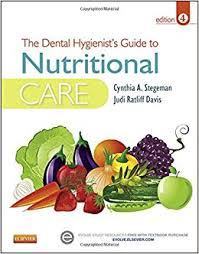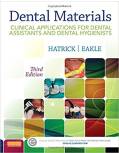Test Bank for The Dental Hygienists Guide to Nutritional Care 4th Edition by Stegeman
INSTANT DOWNLOAD COMPLETE TEST BANK WITH ANSWERS
Dental Hygienists Guide to Nutritional Care 4th Edition By Cynthia A. Stegeman – Test Bank
Sample Questions
Chapter 06: Lipids: The Condensed Energy
Test Bank
MULTIPLE CHOICE
- Three fatty acids attached to glycerol is a triglyceride. Each of the fatty acids attached to a particular triglyceride is the same.
| a. | Both statements are true. |
| b. | Both statements are false. |
| c. | The first statement is true; the second is false. |
| d. | The first statement is false; the second is true. |
ANS: C
Each of the fatty acids attached to a triglyceride can be different. They can be long, medium, or short, and saturated or unsaturated. Medium-chain and short-chain fatty acids are readily digested and absorbed, but most fats in foods contain more difficult to digest long-chain fatty acids.
REF: p. 103
- Lipids provide more energy per gram than carbohydrate, because lipids contain more oxygen in proportion to hydrogen and carbon.
| a. | Both the statement and the reason are correct and related. |
| b. | Both the statement and the reason are correct but are not related. |
| c. | The statement is correct, but the reason is not correct. |
| d. | The statement is not correct, but the reason is correct. |
| e. | Neither the statement nor the reason is correct. |
ANS: C
Structurally, lipids contain less oxygen in proportion to hydrogen and carbon. Note that lipids provide more energy per gram than carbohydrates or protein do.
REF: p. 102
- Saturated fatty acids (SFAs) contain only single bonds. Palmitic and stearic acids, both SFAs, are structural components of the periodontium.
| a. | Both statements are true. |
| b. | Both statements are false. |
| c. | The first statement is true; the second is false. |
| d. | The first statement is false; the second is true. |
ANS: C
Palmitic and stearic acids, both SFAs, are structural components of tooth enamel and dentin. Note that saturated fatty acids are classified according to their degree of saturation, which depends on the number of hydrogen atoms attached to the carbon. SFAs also contain only single bonds, with each carbon having two attached hydrogen atoms.
REF: p. 103
- Oleic acid is classified as a trans fatty acid because it is hydrogenated.
| a. | Both the statement and the reason are correct and related. |
| b. | Both the statement and the reason are correct but are not related. |
| c. | The statement is correct, but the reason is not correct. |
| d. | The statement is not correct, but the reason is correct. |
| e. | Neither the statement nor the reason is correct. |
ANS: D
Although it is true that trans fatty acids are hydrogenated, oleic acid is neither hydrogenated nor is it a trans fatty acid. Oleic acid is classified as a monounsaturated fatty acid because it contains only one double bond.
REF: p. 103 | p. 104
- Excess dietary carbohydrates and protein are converted to fat. These substances are first converted into triglycerides and then stored in adipose tissue.
| a. | Both statements are true. |
| b. | Both statements are false. |
| c. | The first statement is true; the second is false. |
| d. | The first statement is false; the second is true. |
ANS: D
Excess dietary carbohydrates and protein are not converted to triglyceride before being stored in adipose tissue. Triglycerides are the primary form of fat in the body.
REF: p. 103 | p. 106
- Stearic acid is associated with heart disease because it has a detrimental effect on serum cholesterol.
| a. | Both the statement and the reason are correct and related. |
| b. | Both the statement and the reason are correct but are not related. |
| c. | The statement is correct, but the reason is not correct. |
| d. | The statement is not correct, but the reason is correct. |
| e. | Neither the statement nor the reason is correct. |
ANS: E
Stearic acid, found in beef and cocoa butter, does not have a detrimental effect on serum cholesterol.
REF: p. 113
- The strongest dietary determinant of blood cholesterol is dietary saturated and trans fatty acid because they reduce concentration of lipids in the blood.
| a. | Both the statement and the reason are correct and related. |
| b. | Both the statement and the reason are correct but are not related. |
| c. | The statement is correct, but the reason is not correct. |
| d. | The statement is not correct, but the reason is correct. |
| e. | Neither the statement nor the reason is correct. |
ANS: C
Dietary saturated fats and trans fatty acid (known as trans fat) are the strongest dietary determinant of blood cholesterol. The reason is that they significantly increase the concentration of lipids in the blood, referred to as hyperlipidemia. Total dietary fat content also affects serum (blood) lipid levels, but it is the dietary saturated and trans fats that are most detrimental.
REF: p. 113
- Patients should be counseled to substitute foods with trans fats for those with saturated fat, because saturated fat has a less detrimental effect on blood lipids.
| a. | Both the statement and the reason are correct and related. |
| b. | Both the statement and the reason are correct but are not related. |
| c. | The statement is correct, but the reason is not correct. |
| d. | The statement is not correct, but the reason is correct. |
| e. | Neither the statement nor the reason is correct. |
ANS: E
Substituting trans fats with saturated fat is not recommended. Both substances have undesirable effects on blood lipids.
REF: p. 108
- Lecithin, a phospholipid used for energy, is present in all cells. Lecithin is present in thromboplastin, which is necessary for blood clotting.
| a. | Both statements are true. |
| b. | Both statements are false. |
| c. | The first statement is true; the second is false. |
| d. | The first statement is false; the second is true. |
ANS: C
Cephalin, another phospholipid, is present in thromboplastin, which is necessary for blood clotting. Phospholipids include lecithin, cephalin, and sphingomyelin.
REF: p. 104
- Fats with a high proportion of saturated fatty acids can deteriorate and become rancid, because they are converted to peroxides as they oxidize and decompose.
| a. | Both the statement and the reason are correct and related. |
| b. | Both the statement and the reason are correct but are not related. |
| c. | The statement is correct, but the reason is not correct. |
| d. | The statement is not correct, but the reason is correct. |
| e. | Neither the statement nor the reason is correct. |
ANS: D
Unsaturated fatty acids are much more likely than saturated fatty acids to become rancid as they decompose. Through oxidation of decomposition, unsaturated fatty acids form peroxides that may be toxic in large amounts.
REF: p. 104
- Each of the following is true of fatty acids except one. Which one is the exception?
| a. | The carbon chain length is a determinant of flavor and hardness. |
| b. | The degree of saturation is a determinant of melting point. |
| c. | Melting point is the temperature at which a product becomes a gel. |
| d. | Most saturated fatty acids are solid at room temperature. |
ANS: C
Melting point is the temperature at which a product becomes a liquid. The carbon chain length and degree of saturation determine various properties of fats, including their flavor and hardness or melting point. Note that most animal fats, being solid at room temperature, are predominately saturated fats.
REF: p. 104
- Which fatty acid has the most hydrogen atoms?
| a. | Saturated |
| b. | Monounsaturated |
| c. | Polyunsaturated |
ANS: A
Saturation of a fatty acid depends on the number of hydrogen atoms attached to a carbon atom. A saturated fatty acid has two hydrogen atoms attached to each carbon. Monounsaturated and polyunsaturated contain fewer hydrogen atoms in this arrangement. Note that these differences are also due to variations in the type of bond between the carbon and hydrogen atoms.
REF: p. 103
- Hydrogenation results in naturally unsaturated vegetable oils being changed to saturated fatty acids (SFAs). This process changes the proportion of the SFAs, but does not influence the shape of the fatty acid.
| a. | Both statements are true. |
| b. | Both statements are false. |
| c. | The first statement is true; the second is false. |
| d. | The first statement is false; the second is true. |
ANS: C
Hydrogenation not only changes the proportion of the SFAs, it also alters the shape of the fatty acid. When hydrogen atoms are rotated so that they are on opposite sides of the bond, in the “trans” position, the fatty acid is called a trans fatty acid. Note that many foods such as margarines and cooking oils are partially hydrogenated.
REF: p. 103
- Lipoproteins are compound lipids composed or each of the following except one. Which one is the exception?
| a. | Linoleic acid |
| b. | Triglycerides |
| c. | Phospholipids |
| d. | Cholesterol |
ANS: A
Linoleic acid is a polyunsaturated fatty acid. Lipoproteins are compound lipids composed of triglycerides, phospholipids, and cholesterol combined with protein.
REF: p. 104





